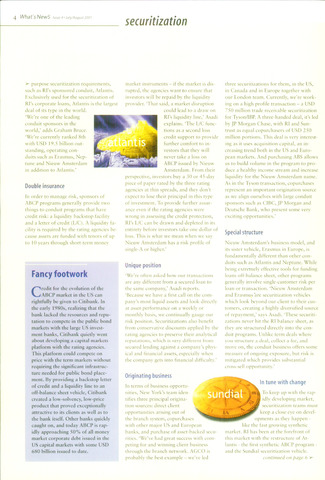securitization
Fancyfootwork
Doublé insurance
Unique position
Originating business
Special structure
In tune with change
What'sNewS Issue 4 July/August 2001
purpose securitization requirements,
such as RI's sponsored conduit, Atlantis.
Exclusively used for the securitization of
RI's corporate loans, Atlantis is the largest
deal of its type in the world.
'We're one of the leading
conduit sponsors in the
world,' adds Graham Bruce.
'We're currently ranked 8th
with USD 19.5 billion out-
standing, operating con-
duits such as Erasmus, Nep
tune and Nieuw Amsterdam
in addition to Atlantis.'
In order to manage risk, sponsors of
ABCP programs generally provide two
things to conduit programs that have
credit risk: a liquidity backstop facility
and a letter of credit (L/C). A liquidity fa
cility is required by the rating agencies be-
cause assets are funded with tenors of up
to 10 years through short-term nioney
Credit for the evolution of the
ABCP market in the US can
rightfully be given to Citibank. In
the early 1980s, realizing that the
bank lacked the resources and repu-
tation to compete in the public bond
markets with the large US invest-
ment banks, Citibank quietly went
about developing a capital markets
platform with the rating agencies.
This platform could compete on
price with the term markets without
requiring the significant infrastruc-
ture needed for public bond place
ment. By providing a backstop letter
of credit and a liquidity line to an
off-balance sheet vehicle, Citibank
created a low-solvency, low-price
product that proved exceptionally
attractive to its clients as well as to
the bank itself. Other banks quickly
caught on, and today ABCP is rap-
idly approaching 50% of all money
market corporate debt issued in the
US capital markets with some USD
680 billion issued to date.
market instruments - if the market is dis-
rupted, the agencies want to ensure that
investors will be repaid by the liquidity
provider. 'That said, a market disruption
could lead to a draw on
RI's liquidity line,' Asadi
explains. 'The I./C func-
tions as a second loss
credit support to provide
further comfort to in
vestors that they will
never take a loss on
ABCP issued by Nieuw
Amsterdam. From their
perspective, investors buy a 30 or 45-day
piece of paper rated by the three rating
agencies at thin spreads, and they don't
expect to lose their principal in this type
of investment. To provide further assur-
ance even if the rating agencies were
wrong in assessing the credit protection,
RI's L/C can be drawn and depleted in its
entirety before investors take one dollar of
loss. This is what we mean when we say
Nieuw Amsterdam has a risk profile of
single-A or higher.'
'We're often asked how our transactions
are any different from a secured loan to
the same company,' Asadi reports.
'Because we have a first call on the com-
pany's most liquid assets and look directly
at asset performance on a weekly or
monthly basis, we continually gauge our
risk position. Securitizations also benefit
from conservative discounts applied by the
rating agencies to preserve their analytical
reputations, which is very different from
secured lending against a company's phys-
ical and financial assets, especially when
the company gets into financial difficulty.'
In terms of business opportu-
nities, New York's team iden-
tifies three principal origina-
tion sources: direct cliënt
opportunities arising out of
the branch system, copurchases
with other major US and European
banks, and purchase of asset-backed secu
rities. 'We've had great success with com-
peting for and winning cliënt business
through the branch network. AGCO is
probably the best example - we've led
three securitizations for them, in the US,
in Canada and in Europe together with
our London team. Currently, we're work-
ing on a high profile transaction - a USD
750 million trade receivable securitization
for Tyson/IBR A three-handed deal, it's led
by |P Morgan Chase, with RI and Sun-
trust as equai copurchasers of USD 250
million portions. This deal is very interest-
ing as it uses acquisition capital, an in-
creasing trend both in the US and Euro
pean markets. And purchasing ABS allows
us to build volume in the program to pro-
duce a healthy income stream and increase
liquidity for the Nieuw Amsterdam name.
As in the Tyson transaction, copurchases
represent an important origination source
as we align ourselves with large conduit
sponsors such as CIBC, JP Morgan and
Deutsche Bank, who present some very
exciting opportunities.'
Nieuw Amsterdam's business model, and
its sister vehicle, Erasmus in Europe, is
fundamentally different than other con-
duits such as Atlantis and Neptune. While
being extremely effective tools for funding
loans off-balance sheet, other programs
generally involve single-customer risk per
loan or transaction. 'Nieuw Amsterdam
and Erasmus are securitization vehicles
which look beyond our cliënt to their cus-
tomers, creating a highly diversified source
of repayment,' says Asadi. 'These securiti
zations never hit the RI balance sheet, as
they are structured directly into the con
duit programs. Unlike term deals where
you structure a deal, collect a fee, and
move on, the conduit business offers some
measure of ongoing exposure, but risk is
mitigated which provides substantial
cross-sell opportuniry.'
To keep up with the rap-
idly developing market,
securitization teams must
keep a close eye on de vel-
opments as they happen -
like the fast growing synthetic
market. RI has been at the forefront of
this market with the restructure of At
lantis - the first synthetic ABCP program -
and the Sundial securitization vehicle.
continued on page 6

